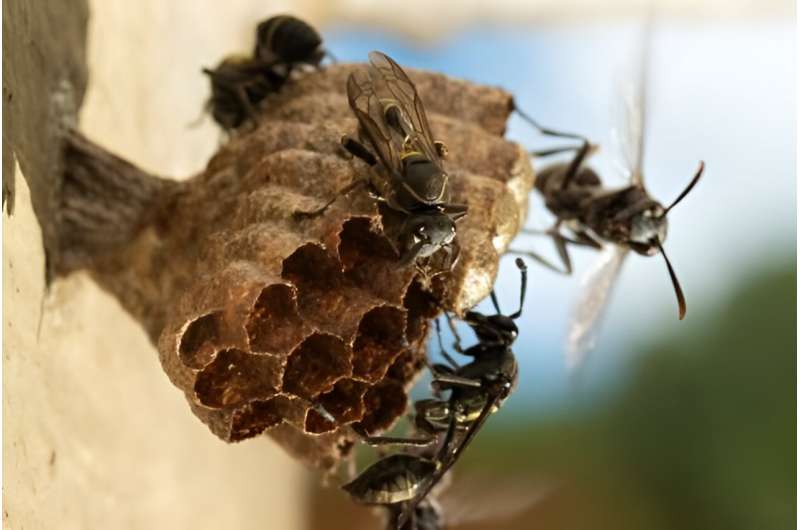This article has been reviewed according to Science X's editorial process and policies. Editors have highlighted the following attributes while ensuring the content's credibility:
fact-checked
peer-reviewed publication
trusted source
proofread
Biopesticide is harmless to mammals but can wipe out colonies of wasps that benefit plants

Some wasps and bees are able to recognize sick nestmates by smell and can prevent their entry into the nest to avert infection of the entire colony, assuring its survival and that of the species in the long run.
A study described in an article published in the journal Environmental Science and Pollution Research shows that this recognition does not happen in paper wasps of the species Mischocyttarus metathoracicus infected by a biopesticide based on the fungus Beauveria bassiana.
The group of authors, led by researchers at the University of São Paulo's Ribeirão Preto School of Philosophy, Sciences and Letters (FFCLRP-USP) in Brazil, determined through molecular, survival, and behavioral assays that the biopesticide kills wasps, which benefit plants by feeding on pests and performing pollination. They also confirmed that wasps infected by the substance are not detected by nestmates.
"The synthetic insecticide [based on imidacloprid] kills in 24 hours and can quickly wipe out entire wasp colonies. The biopesticide is less lethal initially but kills over a period of 19 days, potentially infecting all the insects in a colony and threatening the long-term survival of the species," said André Rodrigues de Souza, a researcher at FFCLRP-USP and corresponding author of the article.
The biopesticide has an advantage over the synthetic insecticide in that it contains spores of the fungus B. bassiana, which infects only insects, sparing mammals, and other animals. The synthetic pesticide tested by the researchers is one of the most widely used and toxic to mammals. It is hazardous to humans if not properly used.
Defensive behavior
In the survival assay, about half the wasps exposed to the biopesticide died. The entire group exposed to the synthetic compound died. The imidacloprid-based pesticide was 50 times less concentrated than the biopesticide, showing how much more toxic it was to these insects.
A control group was exposed to an inert product or water. Under a quarter of these wasps died, further demonstrating the significant lethality of both pesticides.
In the behavioral assays, which were designed to find out whether wasps infected by the fungus were recognized (more attacked or avoided) by nestmates, the researchers used dead wasps as lures on sticks, which they brought near the nest so that resident wasps could interact physically with them. The resident wasps were able to distinguish nestmates from individuals belonging to other nests, which they attacked by biting and stinging.
They recognized nestmates by detecting the odor of their cuticular hydrocarbons, chemical messengers present on the surface of these insects' bodies and used for communication. Nest invasions are common in this competitive species, which defends itself aggressively.
In the study, nestmates infected by the biopesticide and hence bearing fungal spores on the surface of their bodies continued to be accepted by the rest of the colony.
"If they also attacked infected nestmates, the biopesticide wouldn't be such a problem for the colony. They were allowed into the nest and probably remained there, so the 19-day period during which they coexisted with the fungus could be sufficient to transmit spores and infect other adults and larvae, potentially endangering the entire group," Souza said.
Threatened allies
The biopesticide containing many fungal spores is sprayed onto crops so that the fungus can colonize and kill in a few days such pests as caterpillars, coffee borer beetles, red spider mites, eucalyptus weevils, and silverleaf whiteflies, all of which feed on a wide array of crops.
The wasps feed on caterpillars and can be key allies in the biological control of pests. Social insects are also important pollinators of both crops and wild plants.
For Souza, the results of the study serve as a warning not to avoid using biopesticides but to test them as rigorously as synthetic pesticides and manage them adequately.
For example, it would be advisable to avoid applying this biopesticide during the day when the wasps go out to forage and could carry the spores back to the nest.
In recent years, research has shown that mortality testing alone is insufficient to assess the hazardousness of any pesticide, synthetic or biological, for species other than those deliberately targeted by the product. Some compounds may not kill animals immediately but cause loss of fertility, for example, affecting the survival of the species in the long run. In light of these findings, the researchers are now studying the effect on wasp fertility of an essential oil widely used as a biopesticide.
More information: André Rodrigues de Souza et al, A predatory social wasp does not avoid nestmates contaminated with a fungal biopesticide, Environmental Science and Pollution Research (2023). DOI: 10.1007/s11356-023-29770-5
Journal information: Environmental Science and Pollution Research
Provided by FAPESP



















